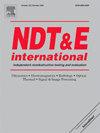编码激励策略以保证超声控制螺栓连接紧固的有效性
IF 4.5
2区 材料科学
Q1 MATERIALS SCIENCE, CHARACTERIZATION & TESTING
引用次数: 0
摘要
超声飞行时间测量是一种成熟的精确测定材料应力的技术。然而,这种方法可能是脆弱的,并且在要求苛刻的应用中缺乏对干扰的鲁棒性,例如螺栓和螺钉组合的过程控制。根据测试对象、材料、外部影响、几何形状或其他干扰,评估结果会导致不正确的预载荷和过程控制失败。本文介绍了几种编码激励方法,以保证超声引导螺栓接头拧紧信号的有效性。提出的方法范围从使用二进制编码序列(纯频率调制)进行激励,到反向计算(振幅和频率调制的组合),再到开关键控(纯振幅调制)。从旁瓣距离和降低激励电压的抗噪性两方面评价了不同的正弦激励方法和最先进的正弦激励方法。研究表明,编码刺激可以激发具有高旁瓣距离的超声回波,即使在拧紧过程中也是如此。这些方法在技术复杂性、计算量和稳定性方面各不相同,需要根据用例进行优化,以便转化为应用程序。本文章由计算机程序翻译,如有差异,请以英文原文为准。
Coded excitation strategies to ensure the validity of ultrasound controlled tightening of bolted joints
Ultrasonic time-of-flight measurement is a well-established technique for accurately determining stress in materials. However, this method can be fragile and lacks robustness to interference in demanding applications such as process control for bolt and screw assembly. Depending on the test object, material, external influence, geometry, or other disturbances, the evaluation results in an incorrect preload and the process control fails. This paper describes several coded excitation approaches to ensure the validity of signals for ultrasound-guided tightening of bolted joints. The methods presented range from the use of a binary coded sequence (pure frequency modulation) for excitation, to inverse calculation (combination of amplitude and frequency modulation), to On–Off keying (pure amplitude modulation). The different approaches and the state-of-the-art sinusoidal excitation are evaluated in terms of side lobe distance and noise immunity by reducing the excitation voltage. We show that Coded stimulation allows excitation of ultrasonic echoes with high side lobe distance in their correlation function, even during the tightening process and based on challenging screws. The methods vary in technological complexity, computational effort and stability which need to be optimized according to the use case for translation to application.
求助全文
通过发布文献求助,成功后即可免费获取论文全文。
去求助
来源期刊

Ndt & E International
工程技术-材料科学:表征与测试
CiteScore
7.20
自引率
9.50%
发文量
121
审稿时长
55 days
期刊介绍:
NDT&E international publishes peer-reviewed results of original research and development in all categories of the fields of nondestructive testing and evaluation including ultrasonics, electromagnetics, radiography, optical and thermal methods. In addition to traditional NDE topics, the emerging technology area of inspection of civil structures and materials is also emphasized. The journal publishes original papers on research and development of new inspection techniques and methods, as well as on novel and innovative applications of established methods. Papers on NDE sensors and their applications both for inspection and process control, as well as papers describing novel NDE systems for structural health monitoring and their performance in industrial settings are also considered. Other regular features include international news, new equipment and a calendar of forthcoming worldwide meetings. This journal is listed in Current Contents.
 求助内容:
求助内容: 应助结果提醒方式:
应助结果提醒方式:


